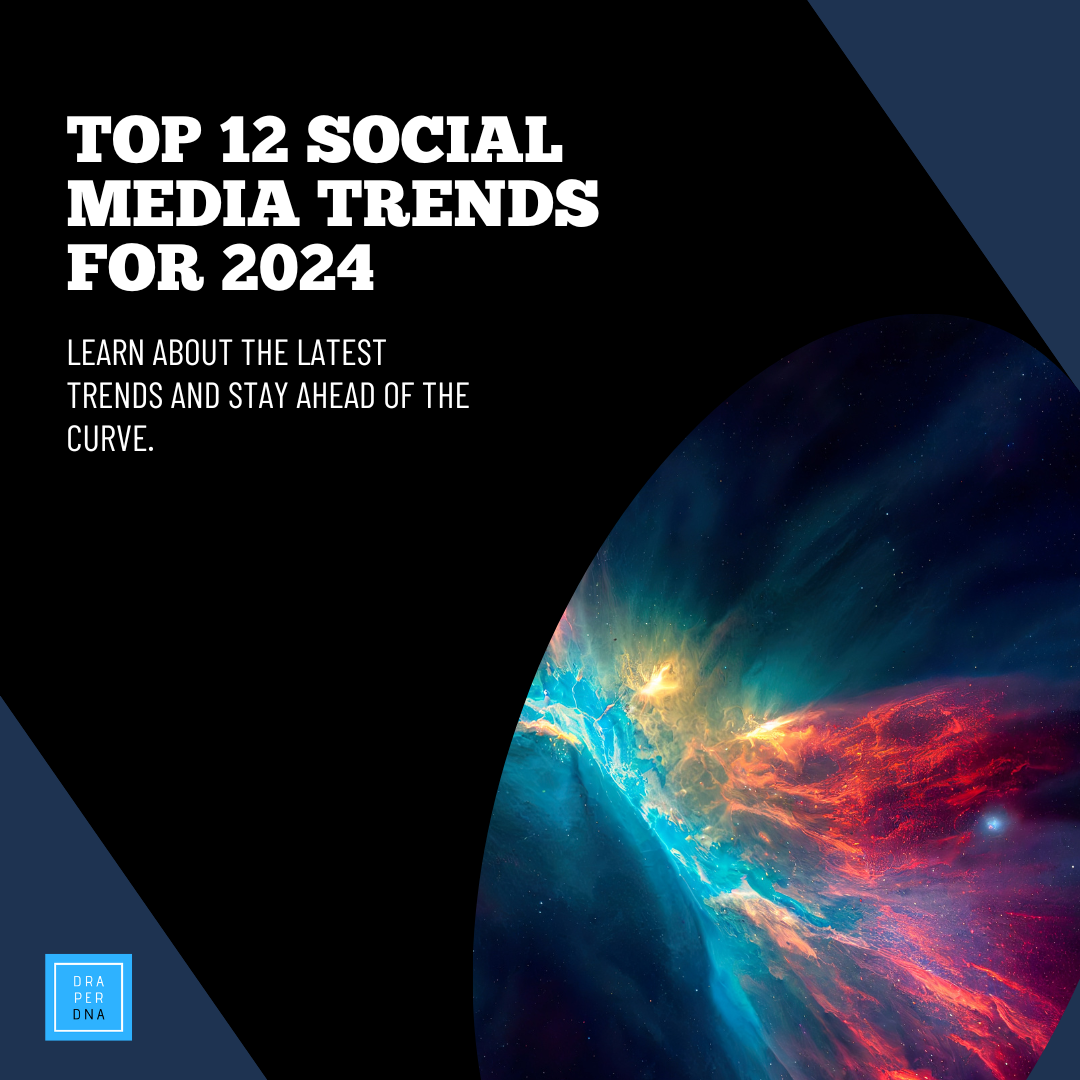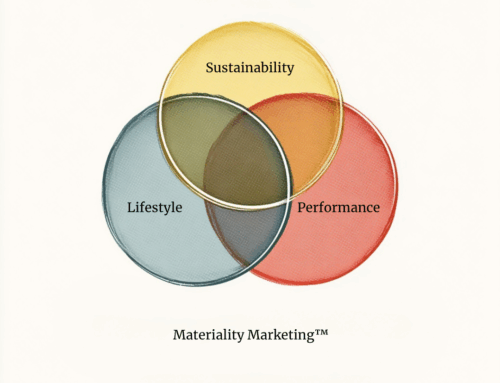The Top 12 Social Media Trends for 2024 That You Must Know
October 16, 2023
Social media are constantly changing. Social media channels are constantly evolving and adapting their features to user appeal and growth potential. This constant flux is also a great opportunity to marketers who are looking for creative ways to reach their audience. It is important to keep up with the latest social media trends for 2024, which are predicted to be dominant this year.
Let’s start with the elephant in your room. The use of social media is steadily increasing. Over 4.74 billion users are active, which represents a 4.2% increase compared to last year’s number. This means that 59.3% are active on social media. It is clear that the pandemic which began in 2020 has contributed to the massive number of users on social media. Data confirms this, with people spending more time on social media.
It sounds amazing, right? This means that you can target a larger market share. It also means more competition, as the focus is on a few high-performing channels. This can lead to saturation of content, user fatigue and budget overruns. Let’s take a look at some social media trends that you should focus on.
Social Media Trends for 2024
Using the following social trends will help you to stand out, increase your brand’s visibility, reach and engagement.
1. Authenticity is key
Since the beginning of the year, social media platforms have been determining success by their authenticity. This is in addition to video content which has been on the list of social media trends for a couple of years. In an age of heavily edited videos and images, and cynicism among customers, authenticity, real-time posts, and posts that the customer can relate to, are now more than just expectations.
2. TikTok & Short Video
YouTube is the most popular video platform. 92% marketers tend to see it as an important part of their marketing strategies. As major social media platforms such as Facebook, Twitter, and LinkedIn enhance their video capabilities in order to keep up with new trends and the increasing popularity of video content, video has gained momentum.
With the growth of TikTok, a new trend has emerged. The short-form video has become a phenomenon among younger audiences. A study shows that TikTok has 1.4 billion active monthly users, and this number will rise to 1.8 billion at the end of 2023. This trend is driven by Generation Z, but other demographics are also following. It is easy to see why short, engaging videos are so popular. These videos are inexpensive and easy to make, which leads to some fantastic user-generated content.
Instagram Reels is the platform that introduced the shorter video format. This type of “microcontent,” or short videos, has gained popularity among them too. This trend is only going to increase as attention span shrinks with each generation. Influencers, for instance, use these short videos in order to promote products and services from their partners to their audience.
3. The effectiveness of micro influencers
Influencer marketing is a trend that will be more prominent this year. Your brand promotion strategy is going to be defined as more people shop at home. This will require you to partner with influencers who have an audience. Influencer marketing can be expensive, even though it is a powerful social marketing strategy.
The cost of promoting brands has risen due to the sudden focus on social media marketing. Well-known influencers also charge a higher price. Smaller businesses lose out on a significant market share. It may be more effective to reach out to smaller influencers within your niche.
Macro influencers are unable to engage with their large followings. Micro influencers have a smaller audience but a much higher engagement rate. They are also cheaper to work with. Collaboration with smaller influencers who are better suited to your market can provide a higher return on investment.
4. Social commerce is on the rise
Set up shop where your customers already are or go there first. Facebook and Instagram were aiming for this. The first platform to offer social commerce features. They had the right idea, given the shift to online shopping as well as the new wave active users. You can be certain that Facebook Shop and Instagram Storefront, if not already, will become the most popular features on the respective platforms.
The modern buyer is more educated than ever. Your brand and your offer will be thoroughly researched by them. This approach to commerce is very promising. Customers value convenience. 54% research products using social media. The way your brand is presented, along with customer reviews and interaction helps customers make informed decisions and purchases faster.
This trend will continue to grow, as more social media channels experiment with features like this one and find new ways to provide businesses with new avenues for sales. This will help them align with the business’s goal of acquiring new customers and audiences’ expectations.
5. Social networks for customer service
Social media networks are far more than just a simple way to connect people. They have become a powerful tool for sharing content. Another piece of the puzzle begins to fall into place with their adoption as a business tool. Social media is becoming a major part of commerce, so it makes sense to use them as a channel for customer service.
To quickly resolve any issues, it is essential to maintain a direct communication line with your customers. It’s a great way to stay in touch with your customers. You can use a feature that is already available. It’s also great PR for brands to publicly help customers.
Twitter, for example, doesn’t offer a feature that is dedicated to customer service. To get the attention of the brand, customers can comment or tag it on an official Twitter. Monitoring your brand mentions is a great way to improve this process. Facebook has dedicated features for your business, such as a common email, automated replies, and a Chatbot.
6. Social media ads that are personalized
Paid advertising is effective, and more than half plan to increase their social media advertising budget. Instagram is the most popular social media platform for advertising, which makes sense given the increasing popularity of video and graphics. Not to mention the recent increase in the audience of the platform.
Facebook, YouTube and LinkedIn are also expected to see an increase in advertising traffic and promotion of content. According to Hootsuite, marketers report that these channels are the most effective for achieving their business goals. They are also quite effective in different kinds of growth.
You will need to be creative with your ad copy to increase visibility and conversion rates. To stand out, use social proof and user generated content. Create ephemeral, limited-time content. It is a great way to play into the concept of FOMO, or the fear of being left out.
7. Brand involvement & social listening
It’s important to be aware of what is being said on the social streets. You can actively participate in the conversation by following it. Talking to many people is messy, and you may lose track of the topic. Conversations can be difficult to follow, especially when they are taking place in multiple places.
Social listening is useful in a variety of ways. You want to be available when your brand is mentioned, especially if the customer has a concern or question. Your brand’s image will be enhanced more by a quick, helpful response than any advertisement. You can be proactive as well, by anticipating topic trends to see how people respond.
The competitor analysis is another great reason to include social listening into your marketing strategy. Monitor the social media interactions of your competitors in order to learn how they interact with their audiences. What they do well and what you could improve in your social strategy. Find out which social media channels they use the most to find new audiences and opportunities for your brand.
8. Tight-knit communities
Not everyone is happy about the sudden rise in social media users. Some users are finding that the noise on social media is becoming a problem and seek out other ways to communicate. They prefer smaller communities where they can share and create content freely. These micro-communities are smaller but have high engagement rates.
Facebook and LinkedIn are perfectly placed to capitalize on this trend, and it is clear. Facebook Groups have seen a significant increase in numbers. This coincides with the socially oriented world we live in, and the desire to interact with other people. Social media has also been a focus for companies who are looking to build up their communities.
This can be used to your advantage if you draw your audience towards a focal point, which can be anything related to your brand or product. Get feedback, provide valuable content, get valuable insights, and start a conversation with your audience. Giving your customers and fans a place to be empowered your brand.
9. Social justice and brand involvement on the rise
Brands are increasingly deciding to engage in a public discussion on social media about social justice and environmental and political issues. It can be either a bold marketing strategy or a genuine involvement that can hurt a certain segment of an audience. More than half social media users and especially younger audiences are in favor of the trend of business activism. They would also like to see brands actively engage on difficult topics.
Consider how Nike, a global brand, uses social marketing as part of their marketing strategy to address social justice issues and inequality. They have measured how their campaign will perform and the PR it will generate. However, their audience was extremely supportive of the move. The positive viral response and increase in sales are evidence of this. This is because they have created content for their audience that speaks to their needs and challenges.
It can also humanize the brand through a content-based approach that involves a subject your customers care about. This can improve their attitude and loyalty to you and your brand. Be careful how you handle a sensitive subject and ensure that your audience approves.
10. Social media and email marketing: a seamless connection
Digital marketing channels are becoming more and more interconnected. Marketers want to close the gap between channels to collect as much data and use it as effectively as possible. Multichannel marketing has been developed to give users a full brand experience. To make this marketing strategy work, you must set the tone for your brand, and then stick with it. You should also align your email and social campaigns so that they work together.
You can combine the two channels by using them for different purposes. Email marketing is focused on conversion, while social media platforms work well for brand awareness. Cross-channel campaigns, such as a social giveaway in exchange for an email subscription are a great place to start.
It’s possible to do this in reverse, too. Upload a segmented list of email addresses onto social media sites and you can better connect with existing users or find new ones. You can use Facebook Lookalike and Custom Audiences to help. You can use this to benefit your ad-retargeting campaign.
11. Augmented Reality
Do you know the digital filters that people usually apply to their photos of real life? These are called augmented-reality effects. AR is a way to enhance real-life content by altering its appearance. This feature is very popular, especially among younger audiences. The rise of augmented reality on social media is not limited to the cute bunny ears and cool sunglasses.
Facebook and Instagram users can now enjoy a better social shopping experience with AR. The technology is still in its early stages, but it has great potential to reach the consumer market.
It is not surprising that AR will continue to trend, as all you need is a smartphone. Marketers are taking note of AR’s growing popularity and are implementing it into their social outreach campaigns.
12. Virtual Reality
VR isn’t moving as quickly as AR, and the user adoption rate is slower but steady. It will continue to grow in popularity as it is one of the most promising technological trends for a fully immersive experience. Another reason for the slow progress of VR technology is its price. After a certain period, new technologies will reach the mainstream and be used by more people.
Virtual reality is a thing, and it’s a fact that Facebook has its back. They have a full range of hardware and content. VR gaming is the focus now, but it will not be the only thing in the future. YouTube has also been experimenting with virtual realities, providing different experiences such as watching concerts, participating in sports, and taking virtual safari tours.
We’re only scratching the surface when it comes to VR. Businesses will eventually follow as the VR audience grows and more people begin to use it. Imagine showing your product in 3D. This will raise the bar when it comes to shopping, purchasing a car or finding a new home. Virtual reality has only just begun.
Social Media Trends Are Changing
They do it again and again. Trends that are popular have humble beginnings. You should always keep an ear to the ground on social media and be alert for any opportunities that may arise.
But be careful not to overextend yourself. Concentrate on a few social media trends for 2024 that you can incorporate into your marketing plan, and make sure to do them well. Pay attention to what your audience wants and needs, then find out what you can do.





